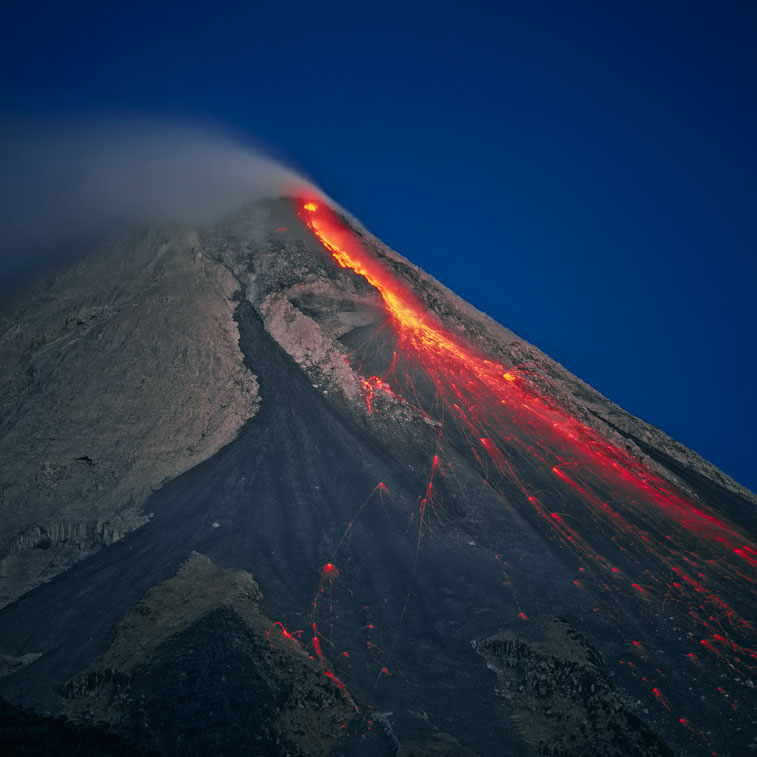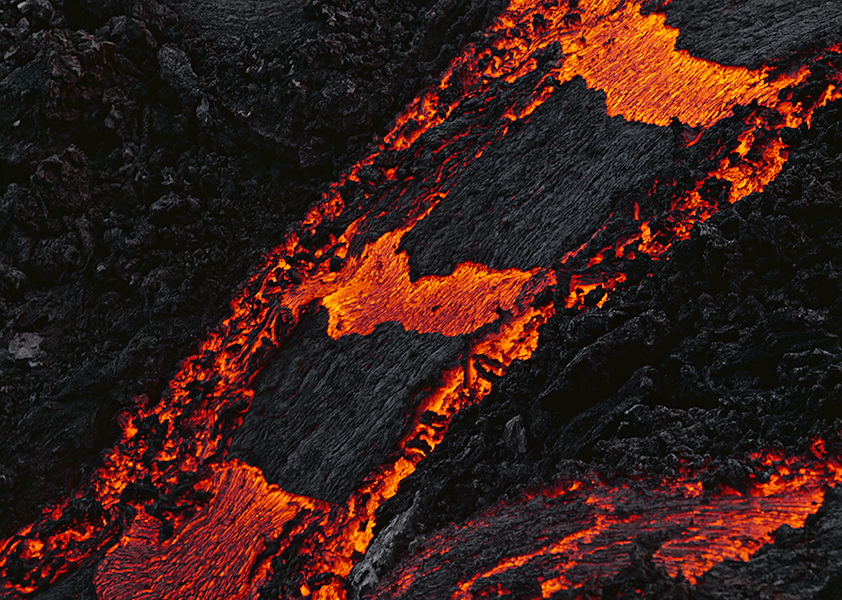Stephen Sparks: A Volcanologist Shares His Thoughts on Risk Management
Stephen Sparks explains how countries and cultures around the world manage the challenges posed by volcanoes — from Indonesia, where volcanism is a daily reality for many people, to Iceland, whence an unexpected ash cloud managed to disrupt global air traffic.

Your research over recent years has looked at ways to predict volcanic activity using a mixture of mathematical and physics-based modelling and on-the-ground monitoring. Do you think we are making real advances in the prediction and management of volcanic activity?
I think we are, yes… I have been almost 4 decades looking at volcanoes and I think there have been dramatic changes and improvements in that time period, partly driven by technology. The techniques [for] monitoring volcanoes have improved greatly [with] new things like satellite remote sensing… At the same time, the sort of modelling you just mentioned has improved a great deal and part of that is also technological: computing power. You can model things now that you couldn’t have modelled even 10 years ago, because the speed of computers has increased greatly. [This] also helps with techniques, because you can handle huge amounts of data now that you couldn’t have done before.
I would hope that myself and… colleagues around the world have also had some insights and developed some new ideas of course.. And then the final reason… that management of volcanic emergencies has improved is [due to] an increasing realisation that its not just science that is needed, If you are monitoring in a volcanic emergency or interacting with the public… civil protection organisations, and often politicians who have got to make decisions about how to deal with the management.. A lot of that, as I say, is not just science. It is having good communications, being able to define risks and make estimates of what those risks are, to help people make decisions. So I think there has been huge improvement in the interaction between science and, if you like, society in the last few decades.
So, it has been a multi-layered, multi-pronged approach.
Yes, that’s right. And although it is almost a cliche, [it’s] what people call interdisciplinarity. When you have a volcano, you need people who are specialists in the volcanic gases, people who are specialists in the chemistry, people who are specialists in earthquakes, people who are expert in modelling. You need a whole range of disciplines to work together in a team and I think that increasing recognition of the need for different sorts of experts to work closely together is again another factor in improvements.
I would just like to focus a little bit on a comment you made at the third world conference on disaster risk reduction in Sendai, Japan. You made the suggestion that a third or more of the world’s global volcanic risk is focused in Indonesia, home to more than 60 active volcanoes and over 200 million people.
So this raises the question: in a world of burgeoning populations and governments that seem to be hard-pressed financially, especially in developing countries, is risk management really achievable? Or is it just achievable at a global level, or only for those countries that can afford it?
There’s a certain assumption in the question: what does one mean by achievable? There is always going to be risk, and risk from volcanoes, because we have got 1500 of them around the world. As you said, some are very active and they are also in… densely populated areas. So there is always going to be volcanic risk, just the way there are going to be hurricanes and typhoons and earthquakes and so forth… The goal really is to reduce that risk — of course you can never get rid of the risk completely. So in principle, you can always do a little bit better. There is not [an] end point… but you can work towards reducing risk and improving resilience of cities. There is always room for improvement and that is what we should be looking at.
Developing countries have a harder time because they have far fewer resources and they have to make priorities — do they spend money on volcano observatories, or hospitals or disease vaccination programs? [There are] different calls on their scarce resources. It is never going to be quite enough.

No, and I suppose the other problem you face is one of complacency: you have societies, such as those living on Java, for whom volcanoes are such a regular part of their existence that they don’t really see them as being something exceptional.
Of course, there are some people in… Yogyakarta… who have seen Mt Merapi erupt most of the time for the last 200 years, so those communities around the volcano… are… used to living with the volcano, and their risk is probably relatively low compared to other communities in Java which have not really experienced volcanic activity much. A good example of that would be Mt Sinabung in Java, which has never had a historical eruption until 2010 — so the people living around that particular volcano are much less used to the dangers… than they would be if they were living around Mt Merapi. So… even within a country like that, there are quite a lot of variations in the knowledge of people about volcanoes and… their preparedness to respond when an eruption starts.
Tell me, how do you manage volcanic risk and the effects associated with volcanic activity? Is there real progress being made in places like Java?
Indonesia I think has done well. As you say, in the 2010 eruption of Mt Merapi, there was a sort of spiritual leader who other people followed around the volcano, [listening] to him rather than the government or the scientists… As you probably know, the spiritual leader was killed during the eruption. The head of the Indonesian volcano observatories recommended an evacuation and actually a large number of people did evacuate. Although there were some deaths in that eruption — a few hundred — it could well have been thousands, if not tens of thousands, had that evacuation not happened.
They saw the Indonesian scientists working with some help from, in particular, the US geological survey scientists, spotted the danger signs, advised the government, and a lot of people did get out of harm’s way. So there was an avoidance of something absolutely catastrophic. Not to say that a few hundred deaths wasn’t tragic, but it could have been an awful lot worse. And in fact, after the eruption, I was told that some of the Indonesian people had T-shirts where they adopted the head of the scientists as a sort of new ‘spiritual leader’.

In the March 2015 Nature News, there was a discussion about the more than 280,000 people killed by volcanoes over the last 4 centuries. Meanwhile, we know that, for instance, more than 30,000 people each year die in motor vehicle accidents in the USA alone. Volcanoes are visually spectacular, but they have a quite limited impact on the world’s 7 billion inhabitants. So, why is the prediction of volcanic events still important?
Compared to… big earthquakes, or floods or typhoons, the death toll from volcanoes has historically been quite minor. There have been a few very big mass casualty events, but they are few and far between. I think there is a much bigger effect which isn’t really reflected in loss of life, which is… disruption of livelihoods and… economic losses, associated with eruptions… So it depends on what you use to measure impact… Montserrat volcano in the Caribbean… probably cost well over a billion and half, possibly 2 billion dollars in terms of losses, and you can measure those losses in all sorts of ways: people losing their homes and having to move somewhere else, cost to deal with the emergency, loss of infrastructure, loss of livelihoods, tremendous disruption to the people of Montserrat.
And if you took the Icelandic ash which disrupted all the aviation in 2010… There was no loss of life but there was something like 200 million Euros a day lost by the airline industry… close to some quite major airlines going bankrupt if it had gone or much longer… [Similarly], 2 or 3 years at there was an ash eruption in Java which closed down Bali for 24 hours, so all the flights could not go in there. So that was again an economic loss for the people (Bali, not to mention the tourists that WE hoping to go there for their holiday An course we are living in a globalised world where, for example, farmers in Kenya couldn’t transport their flowers and beans to Europe for sale during the ash crisis, and had to throw lots of material away — so volcanoes can be very disruptive.
The other element is that volcanoes are really the only natural hazard that could produce a global scale catastrophe… no other hazard apart from meteorites could do that… The last one that happened was in 1815 in Tambor, Indonesia, and that caused famines in Europe and the eastern United States… The global atmosphere was heavily polluted for several years… and that led to major climatic effects which included frosts in New England which basically destroyed all the crops over the summer… And [continuing] on the climate theme, volcanic dust and pollution is of the significant factors in global forcing of climate, so it is an area where we still need to understand an awful lot more if we are going to make a better forecast at global warming.
I would like to come back to the issue of climate change, but there is also lot of public fascination with the so called ‘super volcanoes’. In this context Yellowstone always seems to rear its head, doesn’t it?
It does. The last super volcano eruption was in New Zealand: from Lake Taupo about 23,000 years ago. That is the youngest super eruption on the planet.
So are we all secretly waiting for the big one — a bit like the car wreck at a Grand Prix?
That’s right… the last super eruption on Yellowstone was 600,000 years ago. The last one in New Zealand was a much, much more recent.
Worrying times.
Yes, but… going back to the point that these events are very, very rare… an eruption big enough to devastate the planet may only be, we estimate… probably every 20 or 30 thousand years. So we would be very unlucky to have one of those while we are alive.
And it’s difficult to measure the risk associated with such an eruption in modern times: for example, the recent Icelandic eruptions had this major effect on air travel which for most of human existence didn’t happen.
No, that’s right. Thirty years ago, that same eruption would have minimal impact because there weren’t an enormous number of commercial passenger jets flying around Europe. So that’s an emergent risk that really didn’t exist 30 or 40 years ago.
Considering the other side of travel and tourism associated with volcanic activity: we see people flocking to the likes of Mt Etna, Kilauea in Hawaii and Vanuatu’s Tanna. Much of this attraction occurs in countries that have limited resources and tourism infrastructure. How do those countries balance the demands of tourism with the very real risks that the volcanoes pose?
A lot of things in life are trade-offs. In some ways, having a beautiful volcano which tourists want to see is a good thing. People get a lot of pleasure by climbing… volcanoes make very attractive landscapes… and often they have got interesting stories associated with them… or maybe… myths and legends… They make nice ski resorts. So there are lot of benefits of volcanoes, and in particular benefits for tourism. Countries that are less well-resourced… could create jobs… around volcanoes. I think on a whole it is a good thing.
The answer of course is to manage the threat by having good monitoring observatories which keep an eye on the volcano and obviously create restrictions on people’s access when the volcano threatens to… or does erupt. So I think it’s all manageable. Again, if we take Indonesia, it’s a rapidly developing economy — the sophistication of its science is improving all the time. In general, many countries with volcanoes are improving their ability to manage the risk.
Now very briefly returning to climate change: volcanic eruptions impact climate change negatively through the production of greenhouse gases like carbon dioxide, but also positively through the production of ash and sulphur dioxide as aerosol particles that help to deflect sunlight. So does volcanic activity have some potential to offset, for certain periods of time, some of the effects of climate change?
Big eruptions, usually for a few years after the eruption, will generally cool the earth because the aerosols, sulphuric acid and dust… reflect light and therefore counteract the build-up of carbon dioxide from fossil fuels and so forth in the atmosphere. So it can temporarily halt global warming — if you got a big eruption — but of course it is only a temporary thing.
[However], it might actually create unusual weather in different parts of the world as a consequence…. because the dust and the aerosols… also absorb heat, so the stratosphere actually becomes warmer… The surface of the planet becomes, on average, colder — but actually the stratosphere gets warmer, and this creates global circulation changes which manifest themselves in things like frosts… and actually areas which get a lot warmer than expected, so it changes rainfall patterns. This has an impact on agriculture [which] may not be necessarily beneficial.
I think the other point… is volcanoes are going off all the time. It’s not just the big ones, there’s background effects. The carbon dioxide probably isn’t very important compared to human activity, but the aerosols and the dusts and sulphuric acid… are there. So if we go through a period where, by chance, the rates of [volcanic] activity are increased a bit, then maybe we are suppressing global warming — so it’s actually worse than we think it is. We don’t really know very well what the background effects of natural volcanism are on climate, This is one of the factors that makes the prediction of global warming more uncertain.
So where to from here?
Something again that is linked to society — we have got a number of projects… A less obvious one is that we have got a lot of research money from the mining industry… to look at the natural resource of copper. The reason they have come to… our research group is because about 70 per cent of the world’s copper is found in the eroded roots of old volcanoes, so that’s essentially what they mine to extract much of the world’s copper… We have been given quite generous support by a big mining company (BHP Billiton) to research how it is that some volcanoes become very rich in copper. So we are embarking on that as a new venture and coming up with ideas: of course the modern world wouldn’t run without copper, so that’s… if you like, a different aspect of volcanology contributing to society.
